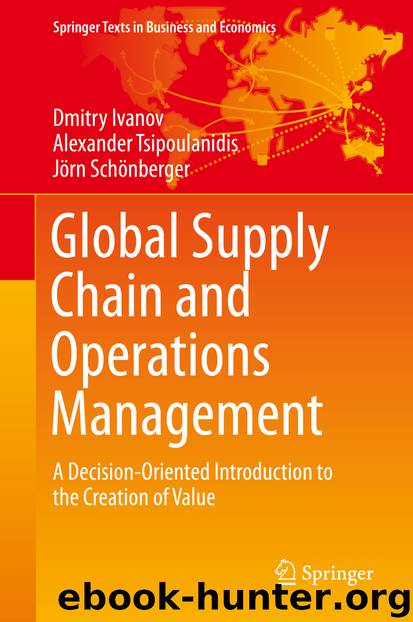Global Supply Chain and Operations Management by Dmitry Ivanov Alexander Tsipoulanidis & Jörn Schönberger

Author:Dmitry Ivanov, Alexander Tsipoulanidis & Jörn Schönberger
Language: eng
Format: epub
Publisher: Springer International Publishing, Cham
8.4 Trade-Off-Based Transportation Network Design
After Mike has finished his presentation, a discussion is initiated about the right distribution network strategy for Bavarian Wood. The board members like the idea of redesigning the supply network based on transshipment. However, they do not feel comfortable with the necessary investment nor with the annual costs for running a transshipment point. With respect to the prospective extension by the inclusion of Rotterdam, Salzburg and Prague they cannot estimate the associated costs and benefits. Therefore, they ask Mike to deliver further explanations about this issue.
Mike expected such a question. He has prepared an executive summary of the section “Factors Influencing Distribution Network Design” from Chopra and Meindl’s (2009) SCM book, where the aforementioned topic is discussed in detail. He distributes these copies and provides an oral survey.
There are two general directions for designing and evaluating transportation networks. First, customer needs must be identified. These needs will be the starting point for the set-up of the transportation network. Second, costs of the installation and deployment of the transportation network have to be determined. Both of these are compromised by the uncertainty of the future circumstances under which the transport network is used. On the one hand, customer needs are unknown, hidden or will change. On the other hand, the costs for running a certain network are subject to external impacts maybe from oscillating customer demand, varying fuel prices, labour costs and so on. Therefore, only a rough estimation of benefits with regard to customer satisfaction and costs is possible.
The major driver of customer satisfaction is the ability to react immediately and with high reliability to an expressed customer demand. If a customer recognizes the need for transportation, this customer wants to have the associated services as soon as possible. Here, the urgency is related to either the quickest possible pickup time or the earliest delivery time. With respect to the Bavarian Wood situation the following might occur. A manufacturing site (Munich, Salzburg or Prague) recognizes that additional material is needed as soon as possible. If the material is stocked (even for a short time but regularly) in one of the import or transshipment facilities contained in the Bavarian Wood supply network, the average re-supply time tends to decrease with the increasing number of network nodes. Depending on the spatial distribution of the nodes where materials are stocked, the re-supply time (which equals the difference between the time of arrival of the additional material and the time when the need is expressed) decreases proportionally, degressively or progressively (see Fig. 8.10).
Fig. 8.10Relation between desired customer response time (x-axis) and the number of facilities required to ensure this response time
Download
This site does not store any files on its server. We only index and link to content provided by other sites. Please contact the content providers to delete copyright contents if any and email us, we'll remove relevant links or contents immediately.
Hit Refresh by Satya Nadella(8854)
The Compound Effect by Darren Hardy(8508)
Change Your Questions, Change Your Life by Marilee Adams(7373)
Nudge - Improving Decisions about Health, Wealth, and Happiness by Thaler Sunstein(7242)
The Black Swan by Nassim Nicholas Taleb(6764)
Deep Work by Cal Newport(6563)
Daring Greatly by Brene Brown(6224)
Rich Dad Poor Dad by Robert T. Kiyosaki(6175)
Principles: Life and Work by Ray Dalio(5961)
Man-made Catastrophes and Risk Information Concealment by Dmitry Chernov & Didier Sornette(5647)
Playing to Win_ How Strategy Really Works by A.G. Lafley & Roger L. Martin(5500)
Digital Minimalism by Cal Newport;(5389)
Big Magic: Creative Living Beyond Fear by Elizabeth Gilbert(5351)
The Myth of the Strong Leader by Archie Brown(5237)
The Slight Edge by Jeff Olson(5200)
Discipline Equals Freedom by Jocko Willink(5157)
The Motivation Myth by Jeff Haden(5003)
Stone's Rules by Roger Stone(4857)
The Laws of Human Nature by Robert Greene(4773)
